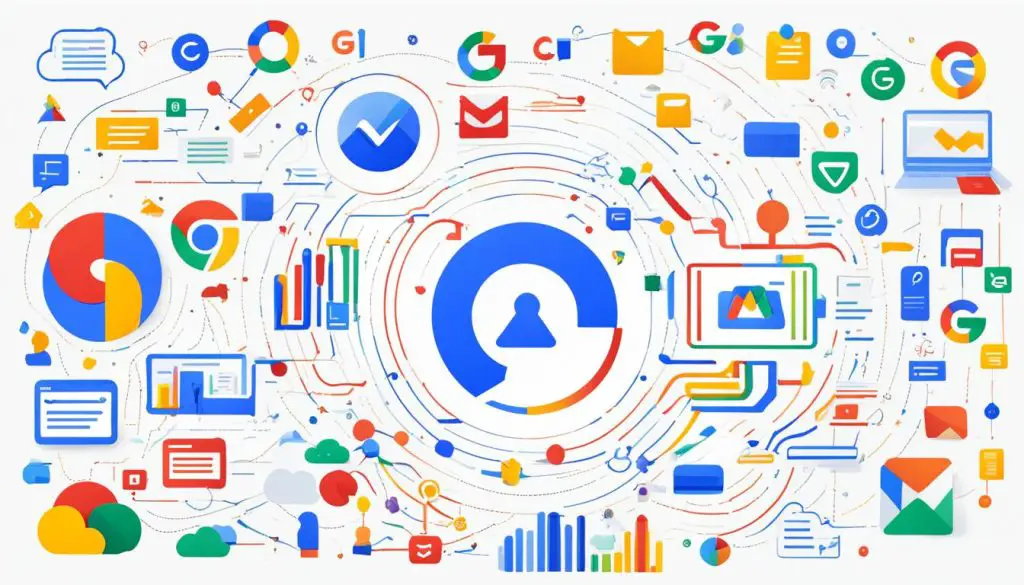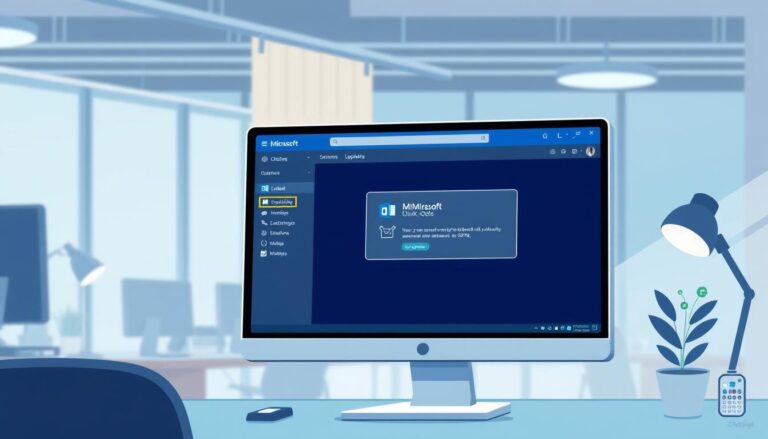What is Google Workspace: Your Ultimate Guide
How can a suite of digital tools revolutionize your business operations, streamline communication, and boost productivity? This is the question we’re diving into today as we explore Google Workspace — an all-in-one platform that brings together email, cloud storage, collaboration tools, and more.
Google Workspace, formerly known as G Suite, offers an impressive array of applications like Gmail, Calendar, Docs, Sheets, Slides, and Drive. This platform is designed to enhance business processes by promoting efficient work execution, seamless team collaboration, and effective customer engagement. But what sets Google Workspace apart from its free counterparts? In a nutshell, it’s the provision of domain-specific email addresses, increased cloud storage, and advanced collaboration capabilities.
Imagine creating detailed documents in Drive, sharing them effortlessly via Gmail, and holding video meetings to discuss complex ideas. This integration and efficiency are at the heart of Google Workspace features. Whether you’re setting up your Google Workspace, managing your Google Workspace email, or exploring the various Google Workspace apps, this guide aims to make your transition smooth and beneficial. To get more insights on Google Drive, click here.
Key Takeaways
- Google Workspace offers packages for different business needs, including Business Starter, Business Standard, and Business Plus.
- Key apps included in Google Workspace enhance collaboration and communication within teams.
- Businesses benefit from domain-specific email addresses, high cloud storage capacity, and advanced security features.
- Google Workspace supports different configurations for tailored access and security settings.
- Flexible pricing options cater to both small businesses and larger enterprises.
- Real-time editing capabilities make teamwork more efficient and productive.
- Millions of users rely on Google Workspace’s ecosystem for their daily communication and collaboration needs.
Introduction to Google Workspace
Google Workspace, formerly known as G Suite, is a comprehensive suite of cloud-based tools engineered to boost productivity and collaboration. With a variety of applications like Gmail, Docs, Drive, Calendar, Sheets, and more, users can work seamlessly from anywhere on any device. This versatility positions Google Workspace as a formidable alternative in the debate of Google Workspace vs G Suite.
Overview of Google Workspace
Understanding what is Google Workspace begins with exploring its core functionality. Offering robust apps such as Gmail for custom domains, Google Drive for expanded cloud storage, and Calendar for enhanced scheduling, it’s an all-in-one platform designed to support business workflows. Each tool integrates natively, streamlining the process of document management and communication, and facilitating efficient collaboration.
History and Evolution from G Suite
The evolution of Google Workspace from G Suite marks a significant milestone. Initially launched in 2006 as “Google Apps for your Domain,” it encompassed Gmail and Google Calendar among other early apps. Fast forward to 2016, the platform was rebranded to G Suite, incorporating comprehensive tools like Google Meet, Google Drive, and Hangouts. By 2020, G Suite transformed into Google Workspace, embracing a name that better reflects its mission of providing a collaborative environment.
Why Businesses Use Google Workspace
Businesses choose Google Workspace for its integrated apps, domain-specific email functionality, and extensive cloud storage. The platform offers 24/7 customer support via phone and email. Dedicated customer support options such as Standard, Enhanced, and Premium further add to its appeal. Furthermore, the consistent availability of productivity tips and training resources, such as instructional videos and feature demos via YouTube, ensures users get the most out of the tools.
The Google Workspace login process is straightforward, ensuring easy access to extensive business tutorials on communication and collaboration techniques. Moreover, Google Workspace’s generative AI tips on Docs, Gmail, Sheets, and Slides enhance productivity and efficiency, making it a preferred choice among businesses worldwide.
For a deep dive into the collaborative power of Google Workspace, you can explore additional resources on the All Things Admin website.
Comprehensive Overview of Google Workspace Features

Google Workspace offers a suite of productivity tools designed to create an integrated and collaborative environment for businesses. The combination of Google Workspace apps, seamless integration, and robust security features makes it a compelling choice for businesses of all sizes.
Main Apps Included in Google Workspace
The principal apps within Google Workspace include Gmail, Calendar, Drive, Docs, Sheets, Slides, and Meet. These main apps provide a comprehensive platform to create, communicate, and collaborate efficiently. Google Workspace’s main apps are designed for speed and collaboration, highlighted by features like the “.new” shortcuts for swiftly creating new documents.
Collaboration and Communication Tools
Google Workspace’s collaboration and communication tools include Chat, Spaces, and Meet, which foster real-time interaction among team members. With features like guest access, users can connect with customers and partners, enabling dynamic collaboration on documents. The integration of tools facilitates editing linked files from within Docs, Sheets, and Slides without navigating away, enhancing overall productivity. The picture-in-picture functionality in Meet across Gmail, Chat, Docs, and other apps aids efficient collaboration, especially in remote work settings.
Security Features and Admin Controls
Security is paramount in Google Workspace. Admin Console provides granular control over apps, data, and user management, ensuring secure data handling. The Endpoint Management feature allows administrators to control device access, enforce restrictions, and remove devices remotely if necessary. Additionally, Google Vault enables the storage and retrieval of crucial business information by setting retention rules and recovering data from suspended accounts or deleted documents. These advanced admin controls are pivotal to the Google Workspace setup.
Integration with Other Apps and Services
Seamless integration is a hallmark of Google Workspace features, enabling enterprises to connect with third-party apps and services for enhanced functionality. This multifaceted integration supports more efficient work processes, ultimately driving productivity. With AI-powered and automated productivity processes, Google Workspace aids in streamlining business tasks, ensuring improved team collaboration.
For more details on the comprehensive features and benefits of Google Workspace, visit the official Google Workspace page to explore how the suite meets diverse business needs.
Google Workspace Pricing and Plans
When considering Google Workspace pricing, it’s essential to recognize the variety of plans tailored to different organizational needs. Google Workspace provides several tiered options, each offering distinct features to cater to businesses of all sizes.
Business Editions
The Business editions are designed for smaller to mid-sized organizations. These plans include:
- Business Starter: Priced at $7.20 per user per month or $6 per month with an annual commitment. It offers 30 GB of storage per user.
- Business Standard: Costs $14.40 per user per month or $12 monthly with an annual plan. It includes 2 TB of storage per user and additional video conference tools like call recording and noise cancellation.
- Business Plus: Available for $21.60 per user per month or $18 per month for an annual plan, providing 5 TB of storage per user and enhanced tools for managing and protecting sensitive data.
These plans can support up to 300 users and offer features like secure business email, video meetings, and management controls.
Enterprise Editions
The Enterprise editions cater to larger organizations, providing:
- Enterprise: Pricing details are available upon contacting sales. This plan offers unlimited user support, advanced security features, video calls with up to 1,000 participants, and in-domain live streaming.
With enhanced administrative controls and advanced data protection, these editions are ideal for large-scale operations.
Comparing the Plans and Their Benefits
Comparing the various Google Workspace plans, the escalation of Google Workspace benefits becomes evident. Business editions offer more storage and meeting capacities as you move from Starter to Plus. Meanwhile, Enterprise editions deliver unbeatable scalability and advanced security for vast user baselines. For a detailed comparison, visit What is Office 365?, where similar offerings are also explored.
Flexible and Annual Pricing Options
Google Workspace pricing offers both flexible and annual options. By opting for annual payments, businesses can benefit from a 20% discount. This structure provides financial predictability and encourages long-term commitment. A noteworthy aspect is the Google Workspace free trial, a 14-day opportunity that allows businesses to experience the platform’s array of features firsthand before committing.
What is Google Workspace: The Ultimate Benefits
Understanding the various benefits of Google Workspace is crucial for businesses looking to maximize efficiency and collaboration. Let’s delve into some of the prominent Google Workspace benefits that make it a preferred choice for organizations worldwide.
Improved Collaboration
Among the foremost Google Workspace benefits is its unparalleled collaboration features. Users can easily co-edit documents in real time using Google Docs, Sheets, and Slides, ensuring everyone is on the same page, quite literally. Shared calendars streamline team scheduling, allowing for seamless coordination. Moreover, each user can have up to 30 alias accounts, enhancing communication flexibility. To top it off, these collaboration capabilities extend beyond internal teams—making it possible to work with external stakeholders without the need for additional licenses.
Enhanced Security
Security is a cornerstone of Google Workspace, offering a plethora of features to keep data secure. Admins can utilize the Admin Console for centralized management of users, data, and apps. Google Workspace Endpoint Management ensures control over device access, adding an extra layer of security. Additionally, Google Vault helps preserve vital data, setting retention rules, and managing user activity tracking. With compliance certifications such as SOC1, SOC2, SOC3, ISO27001, and GDPR, you can be confident that your sensitive information is protected.
Cost-effectiveness
Another key advantage when considering what is Google Workspace is its cost-effectiveness. By consolidating various tools into a single suite, Google Workspace reduces the need for multiple third-party solutions, thereby cutting down expenses. The diverse pricing plans are tailored to fit different organizational needs. Plans like Business Starter offer 30GB storage, while higher-tier plans provide options for 2TB, 5TB, and even unlimited storage in Enterprise editions. According to Forrester Consulting’s Total Economic Impact study, Google Workspace offers a 3-year ROI rate of 331%, making it an economically savvy choice.
Conclusion
In conclusion, Google Workspace emerges as a comprehensive solution that integrates essential tools for communication and collaboration in one seamless cloud-based platform. From Gmail and Drive to Docs, Sheets, and Meet, Google Workspace provides an array of applications designed to enhance productivity and streamline workflows. The platform’s emphasis on real-time collaboration, highlighted by features like simultaneous editing and instant feedback, makes it indispensable for teams working remotely or in diverse locations.
Google Workspace also stands out with advanced functionalities such as AI-powered suggestions in Gmail, smart scheduling in Google Calendar, and robust security measures including encryption and two-factor authentication (2FA). With extensive integration options for third-party applications like CRM systems and project management tools, the platform ensures a holistic digital ecosystem that adapts to varying business needs. For organizations evaluating investment in a reliable productivity suite, the flexible pricing plans starting at $6 per user per month offer scalable solutions suited to businesses of all sizes.
Whether you’re transitioning from G Suite or are new to enterprise-level digital solutions, the adaptability of Google Workspace allows it to meet the evolving demands of today’s dynamic workplaces. Its transformation from G Suite in October 2020 reflects Google’s commitment to continuous improvement and user-friendly design. By enabling access to applications and files from any device with an internet connection, Google Workspace truly embodies the future of work, making it a vital asset for modern businesses. To further explore the setup process or to opt for a free trial, visit the comprehensive Google Workspace guide online.
FAQ
What is Google Workspace?
How is Google Workspace different from G Suite?
What are the core apps included in Google Workspace?
How much does Google Workspace cost?
What are the collaboration features in Google Workspace?
How does Google Workspace ensure security?
Can I use third-party apps with Google Workspace?
How do I set up Google Workspace for my organization?
Is there a free trial available for Google Workspace?
What are the benefits of using Google Workspace?
Source Links
- About the Author
- Latest Posts
Mark is a senior content editor at Text-Center.com and has more than 20 years of experience with linux and windows operating systems. He also writes for Biteno.com

